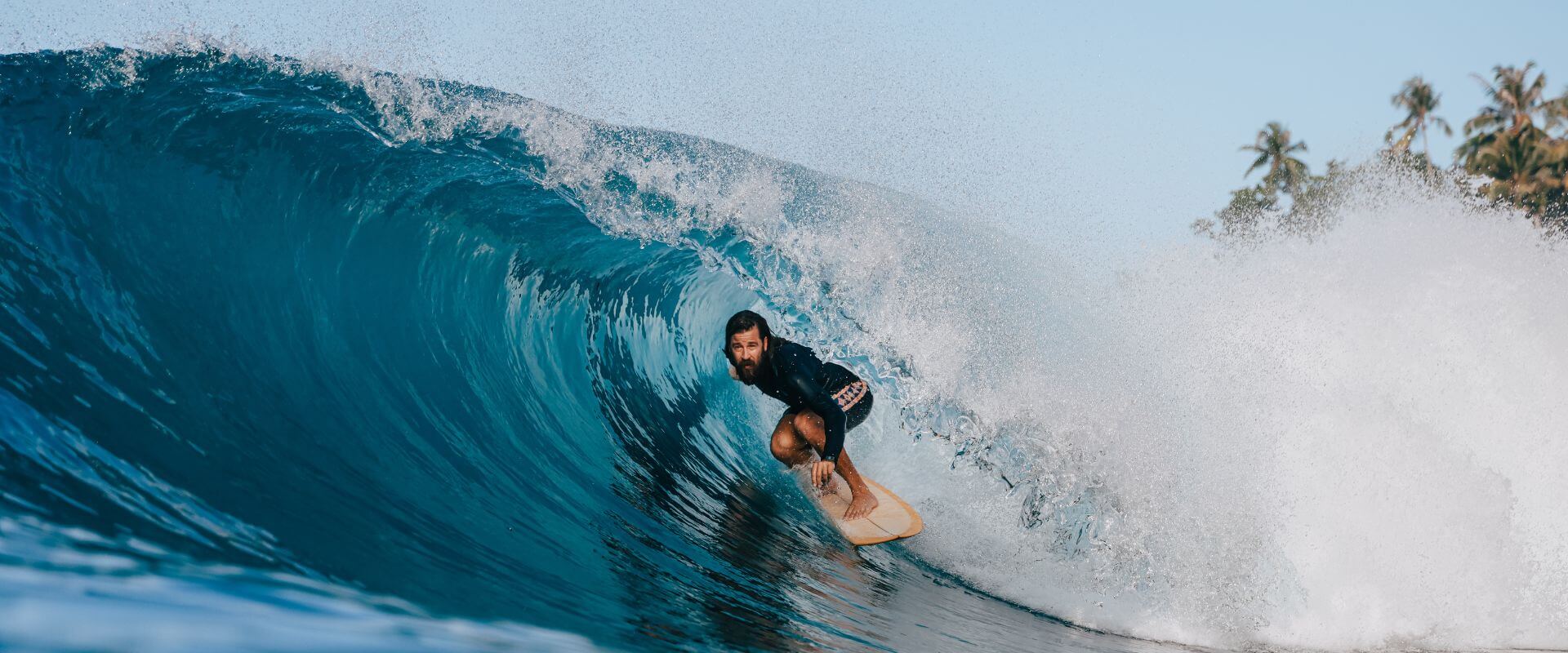Surfing combines a need for core strength and physical fitness, good balance and flexibility, technique, and skill. To become a better surfer, you need to train both your body and mind! Proper training will help you to catch more waves, stay safe, and have more fun in the water.
Training for surfing involves more than just riding waves – it includes specific exercises that improve balance, core strength, and overall fitness. These types of workouts help you stay strong and agile on your board. Besides physical training, mastering core surfing techniques like paddling and popping up are essential for success and improvement.
Nutrition also plays a vital role in your body’s performance. Eating the right foods and staying hydrated improves energy levels and recovery time. On top of that, choosing the right board and keeping your gear in good condition ensures that it lasts longer and performs better.
In this article, we’ll explore how anyone with dedication and the right approach can improve their surfing through exercise, technique improvements, nutrition, and equipment care!
Essential Surf Training Exercises
1. Balance Drills
Equipment like balance boards and stability balls can be great tools to improve balance – which is vital for surfing. Yoga is also great for surfers, as it enhances both balance and flexibility. You can use simple exercises like standing on one leg for extended periods. Try to do it with your eyes closed or standing on a cushion for an extra challenge!
2. Core Workouts
A strong core aids in stability and manoeuvring while surfing. Simple exercises like planks, sit-ups, and Russian twists target your core muscles. You can incorporate medicine ball throws and leg raises to add variety to your workouts. Using an exercise ball for crunches or planks can also help engage your core. Working on your core strength will make your paddling and pop-up movements smoother and more powerful.
3. Cardiovascular Training
Cardio workouts boost your stamina, especially when paddling! Running, swimming, and cycling are effective ways to improve cardiovascular health. High-Intensity Interval Training (HIIT) is another excellent option, mixing short, intense bursts of exercise with rest periods, simulating the start-stop nature of surfing. Regular cardio sessions will help you stay energized and active for longer periods in the water!
4. Strength Training
Building muscle strength is essential for paddling and managing your surfboard. Focus on exercises that target your upper body, legs, and back. Push-ups, pull-ups, squats, and deadlifts are great choices, whilst exercises like dumbbell rows or lat pulldowns can strengthen your back muscles. Consistent strength training will help you manoeuvre your board with ease and power.
Surf Technique Improvements
1. Paddling Techniques
Efficient paddling is crucial in surfing. Practice keeping your body positioned properly on the board, with your chest slightly lifted and your eyes forward. Use long, deep strokes with your hands cupped to pull more water and keep your elbows high to maximize each stroke’s efficiency. You can use resistance bands or weights to increase the effectiveness of exercise. Regular paddling practice helps you catch waves more effectively and conserve energy!
2. Pop-Up Practice
Mastering the pop-up is fundamental to getting on your feet quickly and smoothly. Start by lying flat on your board’s deck. Position your hands flat, underneath your chest. Push up with your arms and focus on keeping your head high, eyes looking forward and landing your feet accurately and flat – your back foot just above the spot where your knees were, and your front foot landing in the place of your hands. Practicing pop-ups on land helps build muscle memory. Try doing a series of pop-ups every day to refine your technique and speed.
3. Wave Reading Skills
Understanding how waves form and break can improve your surfing significantly. Spend time watching the ocean, noting where waves start to break, how they peak, and what they do down the line. By spending time watching how waves form, break, and honing your wave reading skills, you can choose the best waves to ride and improve your overall performance. The best way to practice this is to get in the ocean as much as possible, reading waves is an art that takes time to learn.
These essential exercises and technique improvements will help you become a better surfer. Practice regularly, and you’ll see your surfing improve over time!
Nutrition and Recovery for Surfers
1. Healthy Diet Tips
Eating the right foods is essential for any active surfer. A balanced diet with plenty of fruits, vegetables, lean proteins, and whole grains provides the energy you need! Foods rich in omega-3 fatty acids, like fish and nuts, help with muscle recovery and inflammation. Try to eat smaller, more frequent meals to keep your energy levels steady throughout the day and consume enough calories to ensure you have the stamina to surf to your full potential!
2. Hydration Importance
Staying hydrated is crucial for peak performance. Make sure to drink plenty of water before and after surf sessions. Dehydration can lead to fatigue and cramps and have a negative impact on your surfing. Consider sports drinks if you’re surfing for an extended period, as they can replace lost electrolytes and avoid excessive caffeine and sugary drinks, which can lead to dehydration!
3. Recovery Techniques
Proper recovery is key to maintaining your fitness. Stretching before and after surfing helps reduce muscle soreness and improve flexibility. Ice baths or cold showers can also minimize swelling and speed up muscle recovery! Massage therapy and foam rolling will help release muscle tension and improve blood circulation, and try to ensure you get enough sleep, as rest is critical for overall recovery and performance.
Surfing Equipment and Maintenence
1. Choosing the Right Surfboard
The right surfboard makes a big difference. Beginners should choose a longerboard with more volume or a foam board, which are more stable and easier to ride. Intermediate surfers might prefer a funboard or fish for versatility. Advanced surfers often select shortboards for better manoeuvrability. Shop boards based on your skill level and the type of waves you plan to surf and don’t be scared to ask for advice! The right board should help you surf, not hinder you!
2. Wetsuit Selection
A good wetsuit keeps you warm and comfortable in the water. Choose a wetsuit thickness based on the water temperature you’ll be surfing in. For warmer waters, a 2mm spring suit might be enough. Colder conditions call for a 3/2mm or 4/3mm full suit. Ensure your wetsuit fits snugly but isn’t too tight, restricting movement! Again, ask at your local surf shop for advice.
3. Board Maintenance and Repair
Taking care of your surfboard ensures it performs well and lasts longer. Store it in a cool, shaded place to avoid direct sunlight that can damage the material. If your board gets dinged or cracked, use a board repair kit or take it to a repair shop to fix it promptly. Regular maintenance keeps your gear in top shape and helps you to surf better.
Training for Surfing: Fitness Tips to Ride Longer and Stronger
Regular training can make a huge difference in your surfing skills and overall performance. By focusing on essential exercises, improving your technique, and taking care of your nutrition and equipment, you set yourself up for success. Each aspect – training, technique, diet, and gear maintenance – plays a crucial role in making you a better surfer.
Whether you are just starting or looking to enhance your skills, dedicated practice and proper care of your body and equipment are key. You’ll find yourself catching more waves, staying on your board longer, and enjoying your surf sessions to the fullest!
Ready to take your surf skills to the next level? AWAVE Travel can help you plan the perfect surf trip. We will help you discover amazing surf destinations and give expert advice tailored to your needs!









